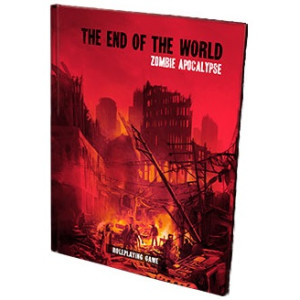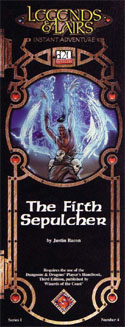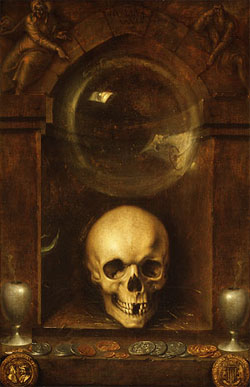End of the World: Zombie Apocalypse is  the first in a series of RPGs from Fantasy Flight Games, each featuring a different apocalyptic scenario: Zombies, Gods, Alien Invasion, Robot Revolt.
the first in a series of RPGs from Fantasy Flight Games, each featuring a different apocalyptic scenario: Zombies, Gods, Alien Invasion, Robot Revolt.
The primary conceit of End of the World is that you’re playing as yourself. The game’s default modus operandi is that you and your friends are sitting down to play an RPG when the apocalypse starts. At that point reality kind of bifurcates: The version of you playing the game stays at the table while the version of you in the game presumably leaves the table to go deal with the apocalypse.
If you’re an experienced gamer, the odds are pretty high that this concept immediately fills you with skepticism: There have been quite a few games that have tried the “play as yourself!” thing. It mostly doesn’t work very well, with the primary problem being people either painting themselves as paragons of virtue, becoming insulted when their fellow players dispute their self-assessments, or both.
End of the World, however, has a very clever method of steering around these problems.
Characters in the game are defined around three categories: Physical, Mental, and Social. Each category has two associated characteristics (Dexterity and Vitality in the Physical category, for example), features (either positive or negative) that affect task resolution, a stress track, and associated traumas.
Character creation basically consists of two steps: First, you get a pool of 16 points that you can use to model yourself on a scale of 1 to 5 in each of the six characteristics.
Second, the rest of the group secretly votes on each of your character’s categories: They can either agree with your assessment, vote that one of the characteristics should be higher, or vote that one of the characteristics should be lower.
The combination of the point buy system (which makes it clear that you’re just modeling a version of yourself, not trying to objectively measure some sort of fundamental truth) and the secret vote (which allows for anonymous tweaking while still giving you final control over exactly which characteristic in the category is adjusted) go a long way towards mitigating the common problems of playing yourself. But the clever twist is that the outcome of the vote also impacts your character’s positive and negative features: If the group decides one of your characteristics should be higher, then you gain a negative feature in that category. If they decide one of your characteristics should be lower, then you gain a positive feature in that category. This incentivizes you to be honest in your self-assessment and also rewards you if the group passes the harsh verdict that you’ve over-estimated your abilities. (It also lets you play the system a bit by, say, deliberately ranking yourself higher than you think you deserve in a category: Either you get a nice ego boost when people agree with you or you get the positive feature you were fishing for.)
The other nice thing about this system is that you can easily use it to create a character other than yourself. So the game pushes you in an interesting direction, but is flexible enough to really let you do whatever you want to with it.
Character creation is easily the game’s best feature.
SYSTEM
Task resolution in End of the World revolves around pools of positive and negative dice. (All the dice are six-sided.) You start with one positive die and you add additional dice for positive features, equipment, assistance, and situational benefits. Then you add negative dice based on the difficulty of the task, your negative features, the traumas you’re currently suffering from, and any situational hindrances.
Then you roll the pool. Each negative die result cancels out a matching positive die result. If you have any surviving positive dice that are equal to or less than the characteristic being tested, you succeed at the task. If you have any surviving negative dice, however, they inflict stress in the matching category.
For example, let’s say you’re trying to run away from a horde of zombies. You have Dexterity 3 and the positive feature of long-distance runner. You also have a twisted ankle from when you jumped out of a hayloft yesterday (that’s a trauma). The GM rules that the number of zombies involved in the pursuit makes escape more difficult, so he adds a negative die to the test. That gives you a pool of two positive dice (one base and one for long-distance runner) and two negative dice (one for your twisted ankle and one from the situation).
Let’s say you roll 3 and 2 on your positive dice. You also roll 5 and 2 on your negative dice. The negative 2 cancels out your positive 2, but you still have a positive 3 (which is equal to your Dexterity score) so you succeed. Because the negative 5 also survived, however, you suffer a point of stress even though you succeeded.
There are a couple of wrinkles to this: If you sustain a certain amount of stress, you suffer a trauma. The more stress you’re suffering from, on the other hand, the more difficult it is to sustain additional stress (as you become hardened to your circumstances). In combat, weapons will grant you additional dice and/or modify the amount of stress you inflict on a successful attack. Suffer enough stress in any category and you are either dead, insane, or catatonic.
But that’s basically it. Ultimately, this system is vapor-thin. It’s not bad, but it’s not particularly robust and it doesn’t really have anything unique to say. (It does have a weak focus on the concept of stress and trauma, but it’s less of a spotlight and more of a 20-watt bulb.)
The couple of places where it does occasionally try to offer more than the most basic support are, unfortunately, kind of laughable. For example, there’s a table of “common gear” which consists of thirteen items featuring descriptions like, “Water Bottle: Storing and transporting water.” Thank god they included that table; I never could have figured out what a water bottle might be used for without it.
(I’m not cherry-picking there, either. They’re all like that. “Flashlight: Spotting things in the dark.”)
The system will get the job done, but it’s not really a selling point for the game. Which means, at the end of the day, that End of the World is going to live or die on its scenarios.
SCENARIOS
Unfortunately, the scenarios are the biggest disappointment in the game.
End of the World: Zombie Apocalypse includes five different versions of the zombie apocalypse: In one version the zombies are the result of a meteor. In another they’re the result of disease. In another they’re purely supernatural. And so forth. The game covers the gamut of possibilities.
Elsewhere in the book, the designers recognize (although not in quite so many words) that any apocalyptic tale basically breaks down into five parts:
- Discovery that the world is coming to an end.
- Acquiring weapons and the means to defend yourself from immediate threats.
- Gather food and medicine and the other supplies necessary for mid-term survival.
- Establish a safe house to provide stability and defense for long-term survival.
- Find long-term safety by figuring out what permanent survival looks like in the new world order.
Where the game truly flirts with genius is in realizing that the specific manifestation of this five act structure depends heavily on the circumstances the players find themselves in and the decisions that they choose to make. So rather than trying to pre-bake a particular package of events, the scenarios in End of the World feature flexible, generic locations.
For example, the first scenario includes a Farm. It describes some of the useful features of the Farm and how those features are likely to be tied into the five part structure of apocalyptic survival (although once again, unfortunately, not in so many words or with so clear an understanding). It lists a half dozen or so events and encounters that could occur on the Farm.
What makes this potentially brilliant is that the GM can take this richly developed generic material and instantly contextualize it in response to the players. If one of the players says, “We need to get out of the city! My Aunt Patty has a farm north of the cities.” Then the GM can flip to the Farm and immediately figure out what happens there. If the players are later driving cross-country when their car breaks down and the GM says, “You can see a little farmhouse off on the horizon.” Alternatively, if the players decided to go to the Mall to gather supplies, then the GM can readily reach for a different location while contextualizing it to whatever local mall the players are familiar with.
I say this is potentially brilliant, however, because End of the World face-plants pretty hard on the actual execution.
The first problem is that it’s not clear that the designers fully understand the potential of the structure they’ve adopted. This leads to a lot of the material shying away from strong choices and instead coming across as mushy and less useful than it could be.
The bigger problem, however, is that there simply isn’t enough material. The first scenario, for example, contains just six locations (and one of them isn’t actually a location): Farm, Horde of Ghoul Rats, House, Mall, Hospital, and Sewers.
What End of the World needed was for each scenario to be fully developed so that, no matter where your players decide to head in your local community or surrounding countryside, you’d be able to flip open the book and find material for it. Instead, the material presented is so thin on the ground that I’m not really sure what the point of it is.
Where the approach becomes particularly ridiculous are the post-apocalyptic scenarios. End of the World also features five scenarios describing what the world is like after the apocalypse (with each of these being paired to one of the apocalypses). But these post-apocalypse scenarios only include three of the generic locations.
You can kinda get away with pointlessly describing six locations in the modern world because, well, it’s the modern world: We presumably already know our own communities. But these post-apocalyptic settings completely transform reality as we know it and then the designers pretend that giving you three unconnected locations qualifies as meaningful guidance for running a scenario there.
CONCLUSION
End of the World features a character creation system with a couple of clever ideas. It features a rule system that gets the job done.
But where it falls apart are the scenarios: In the decision to cover five apocalypses and five post-apocalypses (or possibly in the decision to limit the book to 144 pages), it’s really clear that End of the World has simply spread itself too thin to do any of its scenarios justice.
What makes this bitterly disappointing is that if any one of these scenarios had gotten the attention and the depth of support that it deserved, it would have almost certainly pushed End of the World into being a brilliant game.
Instead, it’s just kind of pointless.
Because the scenarios aren’t developed, they all boil down to, “There are zombies and they wreck shit.” If you’ve ever watched a single zombie movie, you’re not going to gain a single piece of useful information from this book. Meanwhile, the rule system is so simplistic that it, too, isn’t really adding anything to the experience.
What you have, basically, is a book that doesn’t actually do anything. There’s no value being added. Once you’ve read the title, you basically have everything the game is going to offer you.
Skip it.
Style: 4
Substance: 2
Author: Andrew Fischer
Publisher: Fantasy Flight Games
Cost: $39.95
Page Count: 144
ISBN: 978-1-63344-055-5













